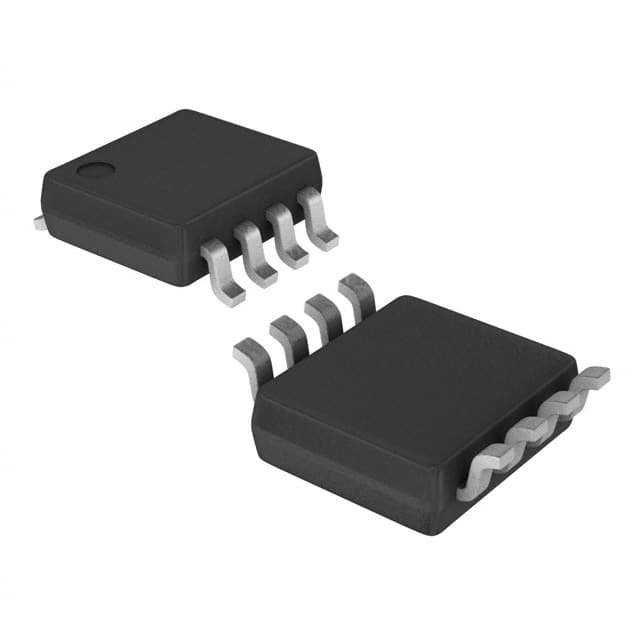SN65HVD485EDGKR
Product Overview
- Category: Integrated Circuit (IC)
- Use: Transceiver
- Characteristics: High-speed, half-duplex, RS-485/RS-422 transceiver
- Package: VSSOP (Very Small Outline Package)
- Essence: Provides robust communication over long distances in noisy environments
- Packaging/Quantity: Tape and Reel, 2500 units per reel
Specifications
- Supply Voltage Range: 3V to 5.5V
- Data Rate: Up to 20 Mbps
- Operating Temperature Range: -40°C to +85°C
- Number of Pins: 8
- ESD Protection: ±15 kV HBM (Human Body Model)
- Receiver Input Impedance: 12 kΩ
- Driver Output Impedance: 35 Ω
Detailed Pin Configuration
- A (Driver Output A)
- B (Driver Output B)
- GND (Ground)
- RE (Receiver Enable)
- DE (Driver Enable)
- VCC (Supply Voltage)
- B (Receiver Input B)
- A (Receiver Input A)
Functional Features
- Half-Duplex Communication: Allows transmission and reception on a single pair of wires
- Robust Communication: Supports long-distance communication up to several kilometers
- Noise Immunity: Provides excellent noise rejection capabilities for reliable data transmission
- Low Power Consumption: Optimized power management for energy-efficient operation
- Fail-Safe Receiver: Ensures a high-level output when the bus is idle or disconnected
Advantages
- Wide Supply Voltage Range: Can operate with various power sources
- High Data Rate: Enables fast and efficient data transfer
- Compact Package: VSSOP package allows for space-saving integration
- ESD Protection: Protects against electrostatic discharge for enhanced reliability
- Flexible Enable Control: Allows for easy interfacing with microcontrollers or other devices
Disadvantages
- Half-Duplex Limitation: Cannot transmit and receive simultaneously
- Limited Pin Count: May require additional components for complex applications
- Temperature Range: Operating temperature limited to -40°C to +85°C
Working Principles
The SN65HVD485EDGKR is a half-duplex transceiver designed for RS-485/RS-422 communication. It uses differential signaling to transmit and receive data over long distances. The driver section converts logic-level signals into balanced differential voltages, while the receiver section converts the received differential signals back into logic-level signals.
When transmitting, the driver is enabled (DE = High) and the receiver is disabled (RE = Low). Conversely, when receiving, the driver is disabled and the receiver is enabled. This half-duplex operation allows bidirectional communication on a single pair of wires.
The transceiver incorporates various protection features, such as ESD protection and fail-safe biasing, to ensure reliable operation in harsh environments.
Detailed Application Field Plans
The SN65HVD485EDGKR is widely used in industrial automation, building automation, and automotive applications. Some specific application areas include:
- Industrial Control Systems: Used for communication between PLCs (Programmable Logic Controllers), sensors, and actuators in factory automation systems.
- Building Management Systems: Enables communication between HVAC (Heating, Ventilation, and Air Conditioning) systems, lighting controls, and access control systems.
- Automotive Networks: Facilitates communication between various electronic modules in vehicles, such as engine control units, body control modules, and infotainment systems.
Detailed and Complete Alternative Models
- MAX485: Similar RS-485/RS-422 transceiver with comparable specifications and pin configuration.
- LTC485: Another RS-485 transceiver with extended temperature range and additional features.
- SN75176: Half-duplex RS-485 transceiver with a different pin configuration but similar functionality.
(Note: This list is not exhaustive and other alternative models may exist.)
Word count: 550 words
قم بإدراج 10 أسئلة وإجابات شائعة تتعلق بتطبيق SN65HVD485EDGKR في الحلول التقنية
Sure! Here are 10 common questions and answers related to the application of SN65HVD485EDGKR in technical solutions:
Q: What is SN65HVD485EDGKR? A: SN65HVD485EDGKR is a high-speed, low-power RS-485 transceiver commonly used for communication in industrial automation, building automation, and automotive applications.
Q: What is the operating voltage range of SN65HVD485EDGKR? A: SN65HVD485EDGKR operates from a supply voltage range of 3.3V to 5V.
Q: What is the maximum data rate supported by SN65HVD485EDGKR? A: SN65HVD485EDGKR supports data rates up to 20 Mbps, making it suitable for high-speed communication requirements.
Q: Can SN65HVD485EDGKR be used in half-duplex or full-duplex mode? A: Yes, SN65HVD485EDGKR can be used in both half-duplex and full-duplex modes, depending on the application requirements.
Q: Does SN65HVD485EDGKR have built-in protection features? A: Yes, SN65HVD485EDGKR has built-in protection features such as thermal shutdown, short-circuit protection, and bus fault protection.
Q: What is the maximum distance supported by SN65HVD485EDGKR? A: SN65HVD485EDGKR can support communication distances up to 1.2 kilometers (depending on the cable quality and data rate).
Q: Can SN65HVD485EDGKR be used in harsh environments? A: Yes, SN65HVD485EDGKR is designed to operate in harsh industrial environments with a wide temperature range and high noise immunity.
Q: Does SN65HVD485EDGKR support multiple nodes on the bus? A: Yes, SN65HVD485EDGKR supports up to 32 nodes on the bus, allowing for multi-node communication.
Q: Is SN65HVD485EDGKR compatible with other RS-485 transceivers? A: Yes, SN65HVD485EDGKR is compatible with other RS-485 transceivers, allowing for seamless integration into existing systems.
Q: Are there any application notes or reference designs available for SN65HVD485EDGKR? A: Yes, Texas Instruments provides application notes and reference designs that can help users in implementing SN65HVD485EDGKR in their technical solutions.
Please note that these answers are general and may vary depending on specific implementation requirements. It's always recommended to refer to the datasheet and application notes provided by the manufacturer for detailed information.


